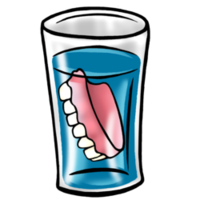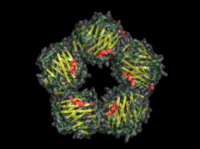Acupuncture and the Gag Reflex

A pronounced gag reflex can be a severe limitation to a person’s ability to accept dental care and for a clinician’s ability to provide it. It can compromise all aspects of dental care from diagnostic procedures to treatment and can be distressing for all concerned. Many things have been tried to reduce it, most without much success.
So I was very interested to see a new study showing that a skinny acupuncture needle inserted at a point that the Chinese call Chengjiang (Ren or Conception Vessel 24) which lies just below the middle of the bottom lip, is an effective method of controlling the gag reflex. Members of the British Dental Acupuncture Society took part in a patient audit. The patients had two upper dental alginate impressions taken (or attempted), one before and one after acupuncture at that point. Before the acupuncture, none of the 37 patients was able to tolerate the procedure, however after acupuncture there was a mean improvement of 53% in measures of gag severity at all stages of the impression taking process. 81% of patients were able to accept the impression taking after acupuncture.
This research will need to be confirmed in a controlled study, but this initial result does not surprise me: I have seen how effective this simple treatment can be.
And as we have said before, good dental care is not just about protecting your pearly whites. Sick teeth and gums can give you a very sick body.
Oral Health and Pointless Tests

I really like the Fox News Channel, but I sometimes worry about some of the medical advice that they dish out. The other morning I heard a dentist recommend that people should ask for a blood test to measure inflammation. She was saying that everyone should have the test, called C-Reactive Protein (CRP). This is really bad advice that is based on a fundamental misunderstanding of research data.
Yes, there is a link between dental disease and arteriosclerosis. And yes, there is a link between CRP and arteriosclerosis. But there is no good evidence that we should be measuring it on a routing basis.

The CRP Molecule
So what’s the problem about measuring CRP? If it is elevated, then what? There is no point in measuring anything at all unless you can take some action, or it guides prognosis. No good doctor would ever recommend treating a lab value. So if the CRP is elevated that would not just mean that it’s time to have a look at his or her pearly whites, it would mean a total body workup. There are dozens of causes for an elevated CRP. I know a lot about the topic: sixteen years ago I wrote one of the early scientific papers on CRP. It may go up if you have a fat tummy, have arthritis, allergies or if you are depressed, have fibromyalgia or irritable bowel syndrome. It also goes up as you get older, if you are physically inactive, or if you happen to have one of the genetic variants that can push it up.
In fact the questions of whether or not measuring CRP would improve coronary risk prediction is the subject of three papers and two editorials in the July 10, 2006 issue of the Archives of Internal Medicine and the July 4, 2006 issue of the Annals of Internal Medicine. In the July 10, 2006 issue of the Archives of Internal Medicine, a team led by Dr Aaron R. Folsom from the University of Minnesota in Minneapolis reported the results of the Atherosclerosis Risk in Communities (ARIC) study, which assessed the association of 19 novel risk markers with incident CHD in 15 792 adults followed up since 1987-1989.
The participants underwent a physical examination, including assessment of major risk factors, at the beginning of the study and every three years afterward. At four times during the follow-up period, researchers collected blood and DNA samples for analysis. Patients continue to be tracked for the development of CHD. Novel markers included measures of inflammation, endothelial function, fibrin formation, fibrinolysis, B vitamins, and antibodies to infectious agents.
Folsom concluded that:
“C-reactive protein level does not emerge as a clinically useful addition to basic risk-factor assessment for identifying patients at risk of a first CHD event. Routine screening is not warranted for any of the other 18 novel risk factors tested, either.”
Another study from Brigham and Women’s Hospital in Boston did suggest that CRP might be helpful in predicting coronary disease in some women. But in an editorial, George Davey Smith from the University of Bristol in England had this to say:
“There are many reasons for skepticism about the role of CRP as a predictor of CHD: CRP may not be causally related to CHD; it remains more expensive than asking patients about their health, lifestyle, and socioeconomic background; and it adds only modest additional predictive ability over conventional risk factors, even in Cook and colleagues’ (i.e. the Brigham and Women’s) study.”
The moral of the story? Random measurements of CRP have not been shown to be of much value.
And be a bit cautious about medical advice on Fox News.
Cranberries and the Inflammation Associated With Severe Gum Disease
There is an interesting study from a team of researchers from Quebec, Canada. The findings, published in the Journal of Antimicrobial Chemotherapy, reveal that natural compounds in cranberries may help ward off periodontitis, or severe gum disease, by serving as a powerful anti-inflammatory agent. This anti-inflammatory effect may be attributed to unique compounds in the fruit that prevent the bacterium P. gingivalis from adhering to the teeth below the gum line. Though it is early days, this new research offers promise for the estimated 67 million Americans affected by periodontitis, the primary cause of tooth loss in adults.
The reason for the study was that cranberries have what are known as "anti-adhesion" activity. This helps guard the body from certain harmful bacteria that cause urinary tract infections (UTIs), gastric ulcers and gum disease. This anti-adhesion activity is primarily due to molecules called proanthocyanidins (PACs) found naturally in cranberries and other foods. Cranberry PACs contain a unique A-type structure that is responsible for this anti-adhesion mechanism of action, while most other foods contain only the more-common B-type PACs.
Researchers discovered that cranberry compounds can reduce the growth of P. gingivalis and subsequent plaque development — the initial step in the development of periodontitis. Periodontitis occurs when inflammation or infection of the gums is left untreated or treatment is delayed. Infection and inflammation spreads from the gums to the ligaments and bones that support the teeth and eventually leads to tooth loss.
In a paper in the Journal of Dental Research the same researchers had previously shown that cells treated with cranberry juice showed significantly less inflammation than cells that were not treated.
Not only can cranberry compounds decrease the growth of P. gingivalis, they may also prevent certain oral bacteria from directly destroying gum tissue itself — another major factor contributing to periodontitis. This may have more widespread implications as recent studies have also linked severe gum disease with an increased likelihood for heart disease and stroke.
The study was part funded by the Ocean Spray agricultural cooperative that sells cranberry juice.
Brushing, flossing and regular professional cleaning reduces the risk of developing periodontitis by helping to prevent the onset of gingivitis, or gum infection. Cranberries may provide an interesting ingredient in the development of new therapeutic approaches for treatment of periodontitis.
Technorati tags: Cranberries Dental disease Heart disease Urinary tract infection Inflammation
Brushing Your Teeth is Good for Your Heart
This was the title of an article in Time magazine and something that I’ve been meaning to discuss for a while now.
We have known for some years now that there can be a link between periodontal bacteria and heart disease, but a new study from the Department of Health Sciences in Kristianstad University, in Sweden and published in the Journal of Periodontology.
The researchers found the presence of specific bacteria in periodontal pockets, which are those areas of tissue surrounding teeth, that might be an explanation for the relationship between periodontal disease and acute coronary syndrome (ACS). ACS is the term used to describe insufficient blood supply to the heart muscle that results in heart disease.
The investigators compared 161 subjects diagnosed with ACS with a control group of people who did not have cardiovascular disease. They found that the bacterial burden – the amount of oral bacteria –was twice as high in the ACS group for the combination for the bacteria streptococci, and three less common bacteria: P. gingivalis, T. forsythia and T. denticola. These findings suggest that this combination of bacteria is the link between periodontitis and ACS.
The periodontal bacteria cause an inflammatory response that elevates the white blood cell count and increases one of the key inflammatory markers: high sensitivity C-reactive protein levels in the blood, a factor which has been linked in past studies to heart disease.
Alveolar bone loss—atrophy of the bones that support your teeth—was also found to be significantly greater among subjects with ACS. The extent of bone loss was more severe in the ACS group than in the non-ACS group with 77%of the participants in the ACS group afflicted with periodontitis versus 42% in the control group.
The study highlights the importance of routine periodontal examinations and at-home dental care, particularly if you have a personal or family history of heart disease.
Technorati tags: Periodontal disease Heart disease Inflammation Dental hygiene
A New Way of Looking at – and Treating – Inflammation
Diseases of both large and small blood vessels are two of the biggest problem facing people with diabetes. Not only is it a huge clinical challenge, but also nature sometimes does our experiments for us. The high rates of coronary and peripheral vascular disease in diabetes can be seen as a kind of experiment of nature: a recognizable set of chemical abnormalities that might shed light on vascular diseases in general. It was those twin factors: a huge clinical problem, and an experiment of nature, that lead me to pick the topic of my research doctorate.
When I was working on my research doctorate in the mid 1980s, I came across a lot of old research that seemed to show links between inflammatory and autoimmune conditions like systemic lupus erythematosus and rheumatic fever, and the eventual development of coronary artery disease. There was also a lot of old and largely forgotten research about the link between some viral infections and the development of coronary artery disease and acute coronary artery occlusions, because some infections can make blood more “sticky.” Inflammation evolved as one of the body’s defence mechanisms.
So I made the proposal – revolutionary at the time – that diabetes, coronary artery disease and a range of other illnesses might be inflammatory rather than degenerative. I soon found inflammatory markers in people with diabetes, that helped predict when someone was running into trouble with their eyes, kidneys or heart. Even with stacks of data, I had to spend a lot of time defending that position, because it also implied that some illnesses thought to be irreversible might not be.
With the passage of time, it has tuned out that I was probably correct. Chronic inflammation, wherever it starts, mat have long-term effects on the body and on the mind. Chronic inflammation increases the risk of diseases of many blood vessels, as well as causing anemia, organic depression and cognitive impairment. Here is a partial list of common conditions in which inflammation is a prominent factor:
1. Rheumatoid arthritis
2. Systemic lupus erythematosus
3. Fibromyalgia
4. Chronic infections
5. Insulin resistance or metabolic syndrome
6. Arteriosclerosis
7. Diabetes mellitus
8. Hypertension
9. Asthma
10. Inflammatory bowel disease
11. Psoriasis
12. Migraine
13. Peripheral neuropathy
14. Alzheimer’s disease
15. Autism
16. Gingivitis
17. Cystitis
The reason for raising the issue is not to say “told you so!”
It is instead that we need to think about inflammation a little differently. There is a mountain of information about the physical aspects of inflammation. We can stop at the simple description of inflammation as a condition in which part of the body becomes reddened, swollen, hot, and usually painful, or we can look below the surface: we can examine inflammation not only as a physical problem, but also as a psychological, social, subtle and spiritual problem. Why bother? Because the deeper approach allows us to understand and to treat and transcend inflammation as never before.
I am going to write some more about specific ways to address inflammation and what it means in future articles. I would also like to direct you to the book Healing, Meaning and Purpose, in which I talk about specific approaches in more detail.
But I would like to start with this.
In Ayurvedic and homeopathic medicine, inflammation is a sign of an imbalance in the vital forces of the body, and the traditional Chinese system agrees: here inflammation is usually a manifestation of an excess of Yang Qi, or a deficiency of Yin Qi. Most of our lives are seriously out of balance: Yang Qi is like a rampaging lion that has been stimulated by:
Acidic foods;
Environmental toxins;
Unwanted sexual stimulation:
Noise;
Discordant music:
Constant demands from others:
Toxic relationships;
Years spent in front of television sets and limitless multi-tasking.
It should be no surprise to learn that all of these inflammatory conditions are increasing rapidly throughout the Western world. Not because we are getting better at identifying them, or we are living longer, but genuinely increasing.
It is wrong to put all the blame on poor diets or inadequate exercise. The problem is more subtle and is a reflection of distorted Information being fed to our bodies, minds, relationships, subtle systems and spiritual relationships.
The great news is that this simple conceptual shift gives us a whole load of new tools for handling these problems, and for using them as catalysts to growth.
In the next few weeks, I am going to drill down and give you some specific guidance that ties into the material in Healing, Meaning and Purpose and the next two that are on the launch pad.
Fasten your seat belt!
Technorati tags: Inflammation Aging Alzheimer’s disease Arteriosclerosis Neuropathy Autism Arthritis Systemic lupus erythrmatosus Fibromyalgia Inflammatory bowel disease Gingivitis






